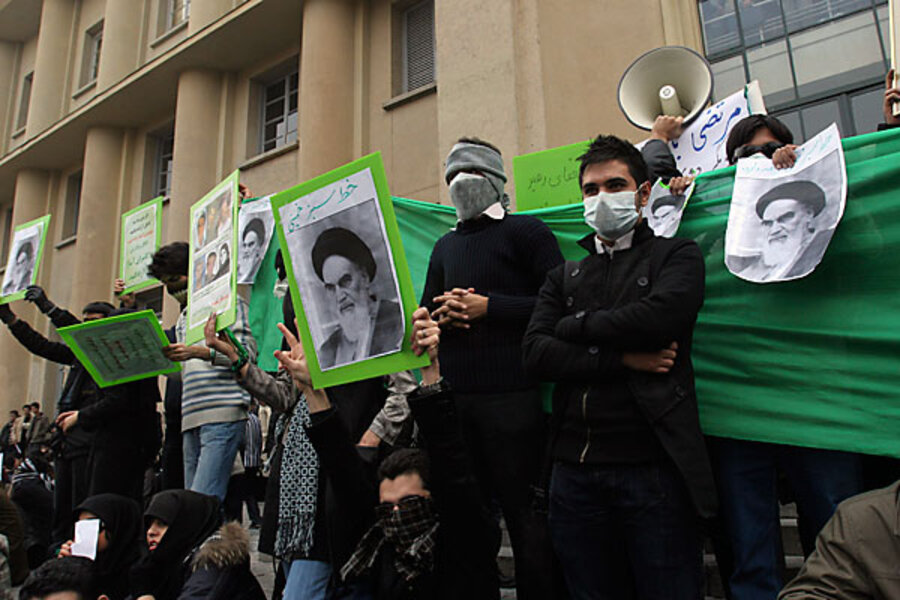Iran protesters say torn Khomeini photos were staged
Loading...
| Istanbul, Turkey
Of all the sanctities in the Islamic Republic, few are more sacred than the memory of Ayatollah Ruhollah Khomeini, father of Iran’s 1979 revolution. So desecration of his image – as shown repeatedly on state-run TV in the past week, and blamed on protesting students – has prompted outrage in Iran.
Prosecutors on Monday announced several arrests, vowed there would be “no mercy toward those who insulted” Khomeini, and claimed that “one of them has confessed.”
The “incident” is being used by arch-conservative elements of the regime to ramp up pressure on reformist opponents – which is exactly why students deny it ever took place, and say it was concocted to discredit them and the Green Movement.
'We have created idols of our clerical leaders'
But the flare-up – with President Mahmoud Ahmadinejad warning that a “hurricane of the revolutionary anger of the nation” is coming – tells much about the state of mind of Iran’s regime after six months of protest over a disputed election, analysts say.
“They are trying to make a big deal out of it,” says Ali Ansari, the director of the Institute for Iranian Studies at St. Andrews University in Scotland. “But this idea that Khamenei can now raise the masses against the opposition on the basis of this one picture – this is exactly what [reformers] are arguing against. They are saying: ‘We have created idols of our clerical leaders.’”
“If anything, most people instinctively feel that this has been generated by the government itself anyway,” says Dr. Ansari. “That’s very revealing. Hardly anyone doubts that this has been stitched-up by the government.”
Protests of the disputed June elections, in which supporters of presidential candidate Mir Hossein Mousavi say he was denied victory by fraud in favor of Ahmadinejad, have widened to target the entire regime.
Khamenei 'can't imply that people don't love him'
Images of Iran’s current Supreme Leader Ayatollah Sayyed Ali Khamenei have been increasingly trampled upon and burnt in recent months. Officially, Ayatollah Khamenei is meant to be “God’s Deputy on Earth,” and therefore divine and infallible – the same post that Khomeini held until his death in 1989.
On Sunday, Khamenei issued a stern warning: “Some have converted the election campaign into a campaign against the entire system.” He said that opposition leaders “should know that something is wrong” if they have the support of the US, France and Britain, “the very symbols of usurpation.”
On the ground in Tehran, some believe that speech by the supreme leader – and protests that have taken place in seminaries and among ideological militants – was the reason for the fracas, and accused the regime of engineering it to justify further crackdowns.
“Clearly Khamenei is doing [it] himself,” says a close observer in Tehran, who asked not to be named. “[Khamenei] was very upset over the chants and burnings of his pictures, but he could not come out and say, ‘You have to respect me’ – he can’t even imply that people don’t love him. So he has to link it to Khomeini.”
“Do you really think that the protesters would concern themselves with the dead first?” asks this observer, who is sympathetic to the opposition camp. “We have a problem with the living first. We can later challenge the ideals and theories of the dead."
Revolutionary Guard calls for 'immediate trial and punishment' of those responsible
Khamenei’s warning against friends who had “strayed” from the revolutionary path was part of a torrent of anti-opposition invective from hard-liners through much of Iran’s Islamic system.
The elite Revolutionary Guard, which is mandated by the constitution to safeguard the revolution, declared in a statement on Sunday that it “won’t tolerate any silence or hesitation in the immediate identification, trial and punishment of those carrying out this ugly insult and the agents behind them.”
Iranian media reported that loyalists rallied at Khomeini’s shrine mausoleum south of Tehran, calling Mousavi a “criminal” who must be tried. Mousavi and former President Mohammad Khatami each said their Green Movement supporters would not desecrate the memory of Khomeini, who in Iran is often referred to as “Imam.”
“If people’s questions were answered and they were not confronted violently we would not see some controversial moves today,” Mousavi said on Monday. Mousavi, the prime minister during much of the first decade of the revolution, when Khomeini was still alive, has said the footage shown on state-run television—which showed only hands tearing up the image of the stern-faced ayatollah – was “very suspicious.”
“People want an end of the security-obsessed atmosphere as in such an atmosphere radicalism grows,” Mousavi was quoted as saying.
“[Iranian] intelligence is capable of anything,” says the observer in Tehran, about the possibility that hardliners stage-managed the incident. “Look at the chants, look at the protests [against the Khomeini burning], look at the comments. They are all so fake, so staged and choreographed.”
“They are scared,” he says of the ruling system, known as the nezam. “These comments are not from a position of strength. They are clearly from a position of fear.”
That view resonates outside Iran also, after six months of protest that the nezam has sought to quash.
“I think they are under serious pressure,” says Ansari at St. Andrews. “Unfortunately, their only reaction to this is to continue getting more extreme themselves. When you say things like ‘obedience to Ahmadinejad is equivalent to obedience to God,’ it’s complete nonsense.”





